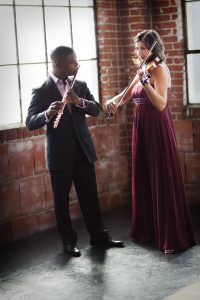Art of Élan: Leave It to Biber!

Demarre McGill & Kate Hatmaker (Photo ©2010 Darin Fong Photography)
Kate Hatmaker and Demarre McGill, the lively spirits who design the chamber music series Art of Élan, have the corner on high concept program design. Their new season “in your dreams” opened Tuesday (October 9) at the San Diego Museum of Art with a program titled “transfiguration.”
(And, yes, they favor the T. S. Eliot lowercase affectation.)
But “transfiguration” is clearly on the high end of high concept notions, and its classical musical repertory is not extensive. There are essentially three choices: Richard Strauss’ massive orchestral tone poem “Death and Transfiguration”; Olivier Messaien’s large choral work “The Transfiguration of Our Lord Jesus Christ,” and Arnold Schoenberg’s string sextet “Transfigured Night.”
Art of Élan went with Schoenberg’s “Transfigured Night” and gave a riveting, soul-scorching account of the composer’s 30-minute expressionist nightmare. The challenge was to find thematic music to balance and lead up to the Schoenberg, and that is where the planners came up short.
But these six young string players captured the roiling, angst-filled center of “Transfigured Night” with vigorous attacks and vibrant thematic arcs. Violist AJ Niles led these attacks with his incisive, full-bodied tone, and violinists Igor Pandursky and Kat Hatmaker provided steel in the upper ranges. But the work is not all angst—otherwise it would have no transfiguration—and when purer sounds were required, cellists Alex Greenbaum and Chia-Ling Chien offered exquisitely detailed and shapely themes.
I was puzzled by the choice of Terry Riley’s string quartet “Sunrise of the Planetary Dream Collector” as the program opener. Ten minutes of intense, busy circular motifs hovering over a claustrophobic harmonic maze does not suggest “transfiguration” to me. I call that stasis.
Another homage to stasis was Christopher Adler’s “Five Cycles” for the Thai bamboo mouth organ, the khaen, an instrumental cousin to the Chinese sheng. Performed confidently by the composer, this short piece—less than 5 minutes long—sounded like a stately hymn: slowly moving harmonic progressions that brought to mind a mystical improvisation on a muted parlor harmonium.
Even with the substantial Schoenberg offering, Hatmaker’s exhilarating yet probing performance of Heinrich Biber’s [php snippet=1] Passacaglia (known as “The Guardian Angel” from his Mystery Sonatas) for solo violin proved the centerpiece of the program. Revealing a radiance I have not previously noticed in her sonority, she boldly communicated the work’s rhapsodic ecstacy without shortchanging its many flights of angelic figuration.
Why don’t more violinists program the significant repertory of this 17th-century Bohemian composer whose music is both profound and virtuosic? Is it because violin teachers think everything begins with Paganini and ends with Fritz Kreisler?
But enough carping from this critic. Thank you, Kate, for the miraculous Biber Passacaglia!
[box] Performers: Igor Pandurski and Kate Hatmaker, violins; Travis Meril and NJ Niles, violias; Alex Greenbaum and Chia-Ling Chien, cellos; Christopher Adler, khaen.
Site: Hibben Gallery at the San Diego Museum of Art, Balboa Park
Next Art of Èlan concert at SDMA: Nov. 20, 2012, featuring Tan Dun’s “Ghost Opera” www.artofelan.org 619.692.2081 [/box]

Ken Herman, a classically trained pianist and organist, has covered music for the San Diego Union, the Los Angeles Times’ San Diego Edition, and for sandiego.com. He has won numerous awards, including first place for Live Performance and Opera Reviews in the 2017, the 2018, and the 2019 Excellence in Journalism Awards competition held by the San Diego Press Club. A Chicago native, he came to San Diego to pursue a graduate degree and stayed.Read more…

Baroque violonists often program Biber. At the San Diego Early Music Society, we had the privilege to present Helene Schmitt a couple of years ago, who played the exact same passaglia, and Sophie Gent (as part of Masques) last season. We won’t have any Biber this season, but Nicola Matteis (another of these great 17th century composers) performed by Monica Huggett in April.